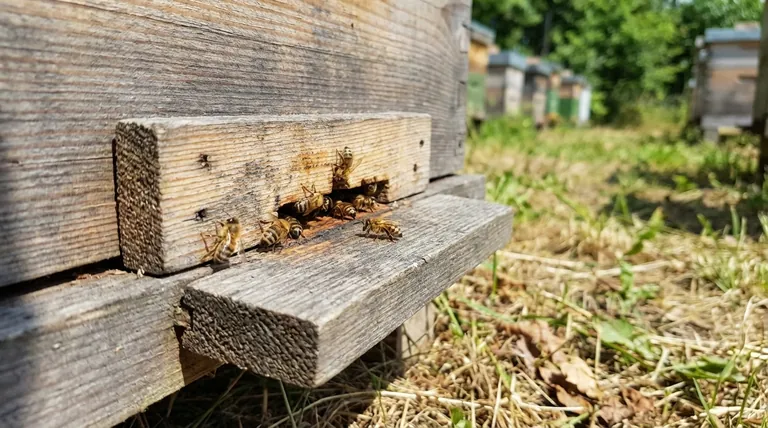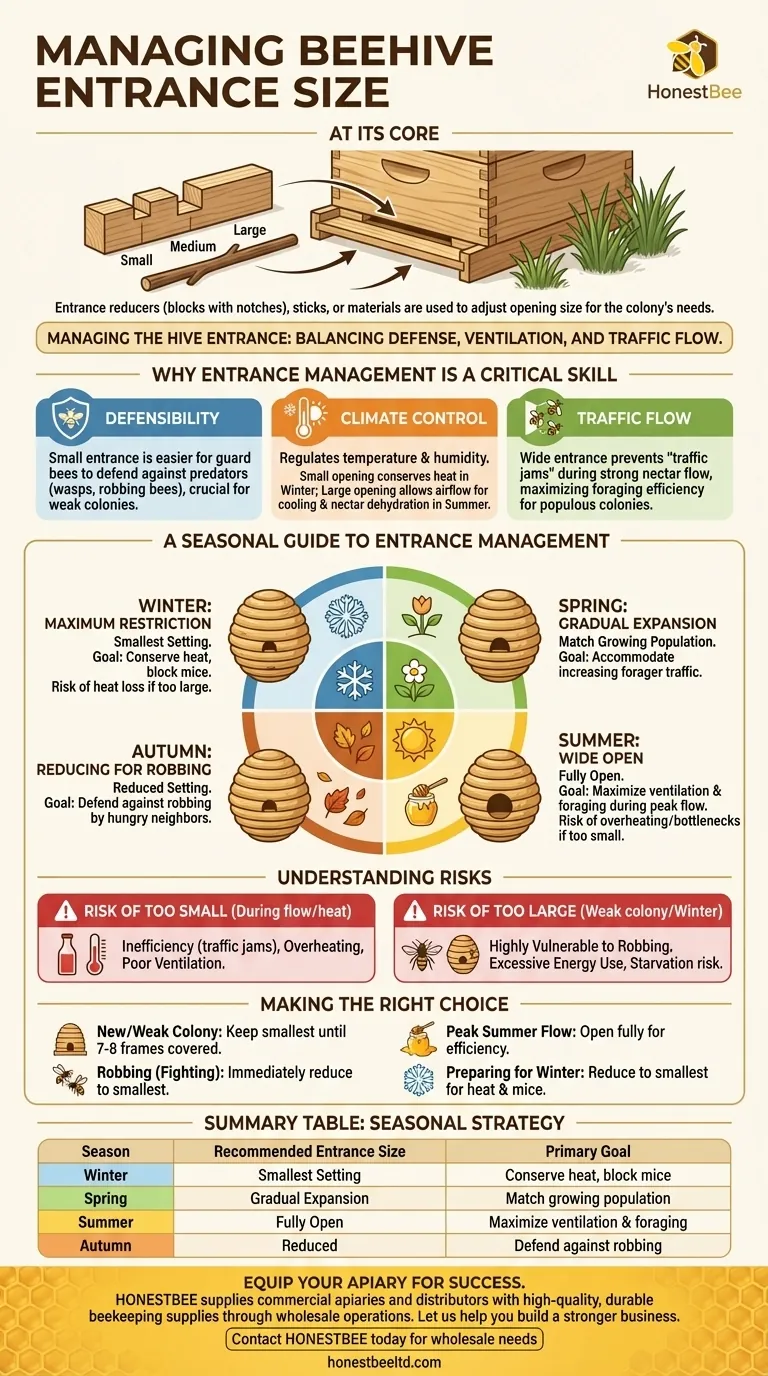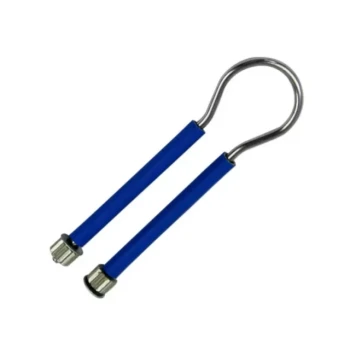At its core, managing a beehive entrance is done with a simple device called an entrance reducer. This is typically a small block of wood with different sized notches, allowing you to set the opening to be large, medium, or small. You can also use a simple stick, clumps of grass, or a piece of wood to achieve the same effect of reducing the entrance to a size appropriate for the colony's current needs.
Managing the hive entrance is one of the most fundamental skills in beekeeping. It's not about simply opening or closing a door; it's a strategic act of balancing the colony's need for defense, ventilation, and traffic flow against the changing seasons and external threats.

Why Entrance Management is a Critical Skill
Adjusting the entrance size is a powerful tool that directly impacts the health, safety, and productivity of your honey bee colony. The correct size depends entirely on the time of year and the colony's population.
The Primary Goal: Defensibility
A beehive is a treasure trove of honey, pollen, and brood, making it a prime target for predators and thieves. A smaller entrance is easier for the colony's guard bees to defend.
This is especially critical for new, small, or weak colonies that don't have enough guard bees to protect a large opening from wasps, yellow jackets, or robbing bees from other hives.
The Secondary Goal: Climate Control
The entrance is the hive's primary ventilation point. Its size plays a crucial role in helping the bees regulate their internal temperature and humidity.
In winter, a small opening minimizes heat loss, helping the cluster stay warm. In the heat of summer, a wide-open entrance is vital for airflow, which prevents the hive from overheating and helps the bees dehydrate nectar into honey.
The Tertiary Goal: Traffic Flow
During a strong nectar flow, thousands of forager bees are constantly flying in and out of the hive. A restricted entrance can create a "traffic jam," slowing down foraging operations and reducing the amount of honey your colony can produce.
A strong, populous colony needs a wide-open entrance during peak season to operate at maximum efficiency.
A Seasonal Guide to Entrance Management
Your approach to entrance size should change dynamically with the seasons. A "set it and forget it" mentality can put your bees at a disadvantage.
Winter: Maximum Restriction
During the cold months, the entrance should be at its smallest setting. This helps the colony conserve precious heat and provides a physical barrier to keep mice from moving in and destroying comb.
Spring: Gradual Expansion
As the weather warms and the queen ramps up egg-laying, the colony's population will begin to grow. You should gradually increase the entrance size to match the colony's expansion and accommodate increasing forager traffic.
Summer: Wide Open
In the peak of summer and during the main nectar flow, the entrance should be fully open. This provides maximum ventilation to prevent overheating and gives the huge number of foragers an unobstructed path in and out of the hive.
Autumn: Reducing for Robbing Season
As nectar sources dwindle in the fall, the risk of robbing from hungry neighboring colonies increases significantly. You must reduce the entrance size again to help your colony defend its vital winter honey stores.
Understanding the Trade-offs and Risks
Choosing the wrong entrance size at the wrong time can create significant problems for your colony.
Risks of an Entrance That's Too Small
The primary risk of an overly restricted entrance during a nectar flow is inefficiency. It creates a bottleneck that slows down foragers.
In hot weather, a small entrance can also lead to overheating and poor ventilation. It can also become clogged with dead bees or debris, although a properly designed reducer minimizes this.
Risks of an Entrance That's Too Large
This is often the more dangerous mistake, especially for a new beekeeper. Leaving the entrance wide open on a small or weak colony makes it highly vulnerable to being robbed out and destroyed by stronger hives.
In winter, a large opening forces the colony to expend more energy and consume more honey to stay warm, increasing the risk of starvation.
Making the Right Choice for Your Colony
Your decision should always be based on observing your colony's strength and the current season.
- If you have a new package, nuc, or weak colony: Keep the entrance on its smallest setting until the population has grown to cover at least 7-8 frames.
- If you see bees fighting at the entrance (robbing): Immediately reduce the entrance to the smallest possible opening to give the defenders a fighting chance.
- If it's the peak of summer with a strong nectar flow: Open the entrance fully to maximize foraging efficiency and hive ventilation.
- If you are preparing for winter: Reduce the entrance to the smallest setting to conserve heat and lock out mice.
By thoughtfully managing your hive entrance, you are actively helping your bees defend their home, regulate their climate, and succeed through the seasons.
Summary Table:
| Season | Recommended Entrance Size | Primary Goal |
|---|---|---|
| Winter | Smallest Setting | Conserve heat, block mice |
| Spring | Gradual Expansion | Match growing population |
| Summer | Fully Open | Maximize ventilation & foraging |
| Autumn | Reduced | Defend against robbing |
Equip your apiary with the right tools for success. Proper entrance management is just one part of a thriving beekeeping operation. HONESTBEE supplies commercial apiaries and beekeeping equipment distributors with high-quality, durable beekeeping supplies and equipment through our wholesale-focused operations. Let us help you build a stronger, more productive business.
Contact HONESTBEE today to discuss your wholesale supply needs.
Visual Guide

Related Products
- HONESTBEE Professional Multi-Functional Hive Tool with Ergonomic Wood Handle
- Multi-Function Plier-Style Frame Grip Hive Tool
- Professional Dual-End Stainless Steel Hive Tool for Beekeeping
- HONESTBEE Professional Long Handled Hive Tool with Precision Cutting Blade
- Professional Multi-Function Stainless Steel Hive Tool
People Also Ask
- What tools are useful when transferring frames from a nucleus hive? Ensure a Smooth and Low-Stress Move
- What is the hole in a hive tool for? A Multi-Tool for Apiary Repairs and Maintenance
- What are the features of a J-hook hive tool? Effortlessly Lift Frames with Superior Leverage
- What should beginners consider when purchasing beekeeping equipment? A Guide to Essential Starter Gear
- What types of hive tools are available for beekeepers? Choose the Right Lever for Your Apiary



















